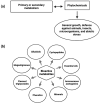A Review on Annona muricata and Its Anticancer Activity
- PMID: 36139697
- PMCID: PMC9497149
- DOI: 10.3390/cancers14184539
A Review on Annona muricata and Its Anticancer Activity
Abstract
The ongoing rise in the number of cancer cases raises concerns regarding the efficacy of the various treatment methods that are currently available. Consequently, patients are looking for alternatives to traditional cancer treatments such as surgery, chemotherapy, and radiotherapy as a replacement. Medicinal plants are universally acknowledged as the cornerstone of preventative medicine and therapeutic practices. Annona muricata is a member of the family Annonaceae and is familiar for its medicinal properties. A. muricata has been identified to have promising compounds that could potentially be utilized for the treatment of cancer. The most prevalent phytochemical components identified and isolated from this plant are alkaloids, phenols, and acetogenins. This review focuses on the role of A. muricata extract against various types of cancer, modulation of cellular proliferation and necrosis, and bioactive metabolites responsible for various pharmacological activities along with their ethnomedicinal uses. Additionally, this review highlights the molecular mechanism of the role of A. muricata extract in downregulating anti-apoptotic and several genes involved in the pro-cancer metabolic pathways and decreasing the expression of proteins involved in cell invasion and metastasis while upregulating proapoptotic genes and genes involved in the destruction of cancer cells. Therefore, the active phytochemicals identified in A. muricata have the potential to be employed as a promising anti-cancer agent.
Keywords: Annona muricata; anticancer activity; bioactive metabolites; ethnomedicinal; pharmacological activities.
Conflict of interest statement
The authors declare no conflict of interest.
Figures








References
-
- Cancer. [(accessed on 31 August 2022)]. Available online: https://www.who.int/news-room/fact-sheets/detail/cancer.
-
- Global Cancer Facts & Figures|American Cancer Society. [(accessed on 31 August 2022)]. Available online: https://www.cancer.org/research/cancer-facts-statistics/global.html.
-
- Minkler S., Lucien F., Kimber M.J., Sahoo D.K., Bourgois-Mochel A., Musser M., Johannes C., Frank I., Cheville J., Allenspach K., et al. Emerging Roles of Urine-Derived Components for the Management of Bladder Cancer: One Man’s Trash Is Another Man’s Treasure. Cancers. 2021;13:422. doi: 10.3390/cancers13030422. - DOI - PMC - PubMed
-
- Sahoo D.K., Borcherding D.C., Chandra L., Jergens A.E., Atherly T., Bourgois-Mochel A., Ellinwood N.M., Snella E., Severin A.J., Martin M., et al. Differential Transcriptomic Profiles Following Stimulation with Lipopolysaccharide in Intestinal Organoids from Dogs with Inflammatory Bowel Disease and Intestinal Mast Cell Tumor. Cancers. 2022;14:3525. doi: 10.3390/cancers14143525. - DOI - PMC - PubMed
Publication types
Grants and funding
LinkOut - more resources
Full Text Sources

